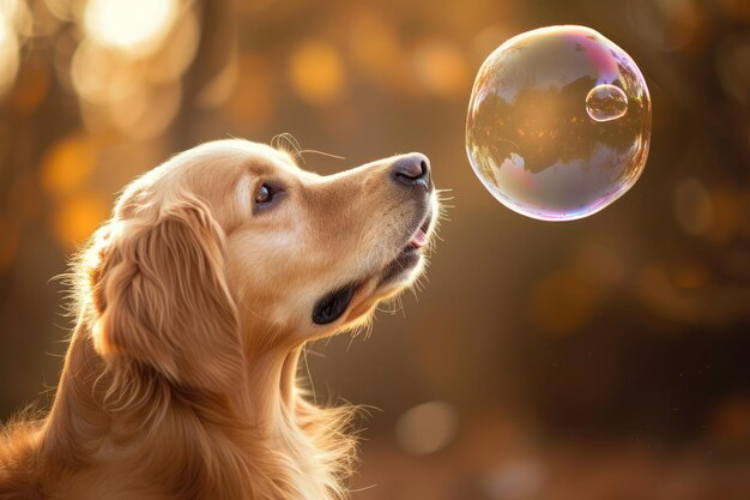Dog training is more than just teaching your dog to follow commands; it’s about creating a healthy environment for them to thrive in, both emotionally and physically. One increasingly popular method is Bubble Theory Dog Training, which focuses on respecting a dog’s emotional boundaries, ensuring they learn in a comfortable and relaxed state of mind. This complete guide dives deep into what Bubble Theory Dog Training is, how it works, and how you can use it to train your dog more effectively.
What is Bubble Theory Dog Training?
Let’s explore this innovative approach to dog training known as Bubble Theory, a unique training technique designed to enhance communication between dogs and their owners
Definition and Explanation
Bubble Theory Dog Training is a positive, reinforcement-based training approach that creates a calm and nurturing learning environment for your dog. The method relies on understanding and respecting your dog’s emotional and physical space, or “bubble,” while teaching desired behaviors. By using rewards and positive reinforcement, the Bubble Theory helps to establish trust and motivation, making training more effective and enjoyable for both the dog and the dog trainer.
The Bubble Theory’s core philosophy is that dogs learn best when they are relaxed and happy. The training works by gradually helping dogs feel comfortable in various environments while maintaining their emotional balance. This means that dogs are less likely to become anxious or overwhelmed, leading to better learning outcomes.
Understanding the Concept of a Dog’s “Bubble”
A dog’s “bubble” refers to its personal space or comfort zone areas where they feel secure. The size of this bubble varies depending on the dog’s breed, temperament, and life experiences. Some dogs have large bubbles and are uncomfortable with strangers or other dogs being too close, while others are more sociable and have smaller bubbles.
Recognizing and respecting your dog’s bubble is key to effective training. If you push a dog too far beyond their bubble, they may become anxious, leading to reactive or unwanted behavior. Bubble Theory Dog Training teaches you how to work within your dog’s comfort zone, gradually expanding it through controlled exposure.
How Bubble Theory Differs from Other Training Methods
Bubble Theory Training stands out from traditional training methods by focusing on a dog’s emotional state and space. Unlike dominance-based training or methods that rely on punishment, Bubble Theory uses positive reinforcement and careful attention to the dog’s comfort level. The goal is to create a low-stress, high-reward environment where dogs feel safe, making them more receptive to learning.
Understanding the Science Behind Bubble Theory
Let’s explore how understanding the science behind bubble theory helps us visualize the bubble around us and its impact on our interactions. This foundational knowledge sets the stage for effective bubble training
Why Bubble Theory Works: The Psychology and Science
The effectiveness of Bubble Theory Dog Training lies in its grounding in psychological principles, specifically operant and classical conditioning. Operant conditioning involves rewarding desirable behaviors to reinforce them, while classical conditioning creates associations between behaviors and positive outcomes.
A key element of Bubble Theory is working at the edge of a dog’s emotional threshold, or “bubble.” This is the point at which the dog is aware of a trigger but not yet reactive. By carefully managing this threshold and using rewards, you can help the dog remain calm while learning new behaviors, preventing emotional overload.
Core Components of the Bubble Theory
- Identifying the Bubble: The first step is to recognize your dog’s bubble or comfort zone. This is unique to each dog and plays a critical role in the training process.
- Obedience and Impulse Control: Basic obedience skills, like sit, stay, and come, along with impulse control, are crucial for the successful implementation of the Bubble Theory.
- Controlled Exposure: This involves gradually exposing the dog to triggers (e.g., other dogs, strangers) from a distance where they remain calm. The goal is for the dog to notice but not react.
- Incremental Progression: Steadily increasing the level of exposure, either by reducing the distance or increasing the intensity of the trigger, while ensuring the dog stays within their comfort zone.
The Role of Positive Reinforcement in Bubble Theory
Positive reinforcement is at the heart of Bubble Theory Dog Training. By rewarding your dog with treats, praise, or toys for good behavior, you create a positive association with training sessions. This method not only helps to reinforce desired behaviors but also makes the learning process enjoyable for your dog.
Implementing Bubble Theory in Dog Training
Let’s apply bubble theory to your dog training method, helping you keep your dog attentive, as dog training is based on effective communication and connection
Creating a Safe and Comfortable Environment
Training success begins with creating an environment where your dog feels safe. This might mean setting up a quiet room or a fenced yard, free from distractions. Start with small, manageable training sessions and gradually build up the complexity as your dog gains confidence.
You May Interested: How to Train a Stray Dog
Minimizing Distractions and Managing Thresholds
Distractions can disrupt your dog’s ability to focus and learn. To minimize distractions, turn off loud devices, reduce background noise, and make sure the training area is calm. Being aware of your dog’s emotional threshold is essential—avoid pushing them too far too quickly.
Using Controlled Exposure and Incremental Progression
Controlled exposure involves gradually introducing triggers while maintaining enough distance so your dog remains calm. This method helps prevent fear or aggression and ensures that your dog feels comfortable progressing at their own pace. Over time, you can reduce the distance and increase exposure intensity as your dog becomes more confident.
Benefits and Challenges of Bubble Theory
Let’s delve into Bubble Theory, exploring how the size of the bubble affects a dog’s learning experience and behavior.
Reduced Stress and Anxiety for Dogs
Bubble Theory reduces stress by focusing on the dog’s emotional well-being. By respecting their bubble and using positive reinforcement, dogs are less likely to experience anxiety or fear, which often accompany harsher training methods.
Improved Obedience and Behavior
Bubble Theory helps improve obedience by teaching dogs to follow cues in a relaxed state. This approach ensures that training is effective in the long term and creates a strong bond between the dog and the owner.
Overcoming Common Obstacles in Bubble Theory Training
Challenges in Bubble Theory training may include distractions, lack of impulse control, or inconsistent training schedules. Overcoming these obstacles requires patience, consistency, and adherence to positive reinforcement techniques.
Case Studies and Real-Life Examples
Discover case studies and real-life examples that emphasize the connection between animal behavior, a stress-free environment, and the ability to recognize signs of discomfort
Success Stories and Examples of Bubble Theory in Action
Many dog owners have found success with Bubble Theory, particularly with dogs who are reactive or anxious. Real-life examples show that with controlled exposure and patience, even dogs with challenging behaviors can become more obedient and relaxed over time.
Lessons Learned and Takeaways from Real-Life Scenarios
The main takeaway from Bubble Theory training is that it requires patience and persistence. The approach is adaptable to each dog’s unique needs, making it a humane and effective training method.
Choosing Bubble Theory for Your Dog
Let’s explore how the bubble theory can be applied to ensure your dog’s comfort and happiness by understanding the size of the bubble around them
Why Bubble Theory is a Humane and Effective Approach
Bubble Theory is a compassionate training method that respects your dog’s emotional state. It is particularly effective for dogs that are anxious, reactive or have larger personal bubbles.
Customizing Bubble Theory to Each Dog’s Needs
Every dog is different, and Bubble Theory allows for customization based on your dog’s specific emotional and physical needs. By tailoring the approach to each dog’s temperament, you can ensure more effective and lasting results.
Addressing the Root Cause of Behavioral Issues
Bubble Theory addresses the root cause of many behavioral issues fear, anxiety, or discomfort by focusing on a dog’s emotional state. This method helps create a calm, balanced dog who responds positively to training.
Getting Started with Bubble Theory
Getting Started with Bubble Theory is essential, as dog training is an effective approach to mastering new skills through a structured training program
Step-by-Step Guide to Implementing Bubble Theory
- Identify Your Dog’s Bubble: Observe your dog’s behavior and determine their comfort zones.
- Introduce Positive Reinforcement: Use treats and praise to reward good behavior.
- Practice Controlled Exposure: Gradually introduce your dog to triggers, maintaining enough distance to prevent anxiety.
- Progress Slowly: Avoid rushing the process—expand your dog’s bubble gradually.
Conclusion
Bubble Theory Dog Training is a gentle and effective approach for creating a well-behaved and happy dog. It requires patience, consistency, and a deep understanding of your dog’s emotional needs. We encourage you to try Bubble Theory with your dog and experience the positive impact it can have on both obedience and well-being.
Frequently Asked Questions and Answers
What is Bubble Theory Dog Training?
It is a dog training approach that focuses on creating a calm, comfortable environment for dogs to learn, using positive reinforcement.
How does Bubble Theory differ from other training methods?
Bubble Theory emphasizes a dog’s emotional state and personal space, unlike other methods that may rely on dominance or punishment.
What are the core components of the Bubble Theory?
Key components include identifying your dog’s bubble, using controlled exposure, and rewarding positive behavior through positive reinforcement.







